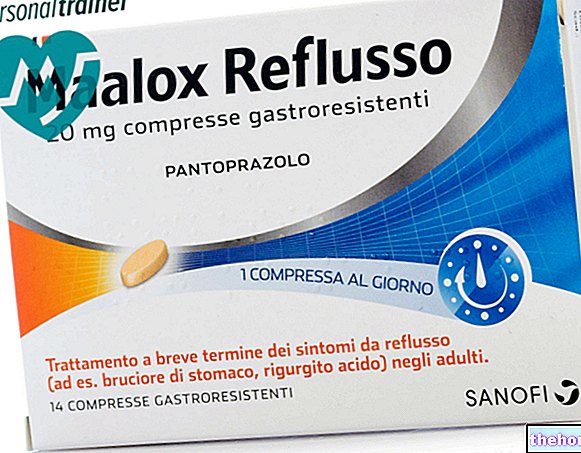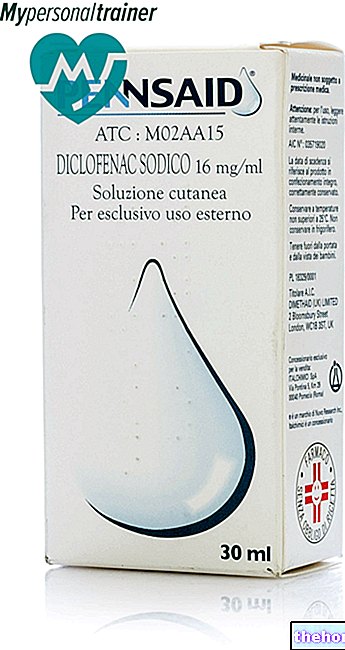Active ingredients: Acetazolamide
DIAMOX 250 mg tablets
Indications Why is Diamox used? What is it for?
PHARMACOTHERAPEUTIC CATEGORY
Antiglaucoma, diuretic, antiepileptic drug.
THERAPEUTIC INDICATIONS
Diamox is indicated in the treatment of heart failure edema.
In patients with prevailing left heart failure excellent results are obtained, with disappearance of pulmonary edema and improvement of dyspnea after a few days.
Diamox is also indicated in glaucoma
In addition to glaucoma, Diamox is effective in situations in which ocular edema exists.
Diamox is also indicated as an adjuvant in the treatment of epilepsy.
The best results were obtained in young subjects suffering from petit mal, but favorable results were obtained in a considerable percentage of cases of grand mal of mixed forms, myoclonic spasms, etc.
Contraindications When Diamox should not be used
Hypersensitivity to the active substance or to any of the excipients.
Acetazolamide can cause a mild acidosis; its use in hyperchloremic acidosis may therefore be contraindicated.
Hypokalemia
Hyponatremia
Acetazolamide is also contraindicated in cases of overt renal and hepatic insufficiency, including cirrhosis (due to the risk of hepatic encephalopathy). Adrenal insufficiency
Prolonged administration of acetazolamide is contraindicated in subjects suffering from chronic non-congestive angle-closure glaucoma (the treatment can allow an organic closure of the angle while the worsening of glaucoma is masked by the lowering of intraocular pressure).
Acetazolamide is generally contraindicated in pregnancy and lactation (see section Special warnings)
Precautions for use What you need to know before taking Diamox
Suicidal ideation and behavior have been reported in patients treated with antiepileptic drugs in their various indications. A meta-analysis from placebo-controlled, randomized antiepileptic drug clinical trials also showed a small increase in the risk of suicidal ideation and behavior. The mechanism of this risk is unknown and the available data neither suggest nor exclude the possibility of an increased risk with Acetazolamide as an adjuvant in antiepileptic therapy.
Therefore, patients should be monitored for signs of suicidal ideation and behavior, and appropriate treatment should be considered. Patients (and caregivers) should see their physician if signs of suicidal ideation or behavior emerge.
Fatal events have occurred due to severe reactions to acetazolamide (sulfonamides and sulfonamide derivatives), such as Stevens-Johnson syndrome and toxic epidermal necrolysis, fulminant hepatic necrosis, agranulocytosis, aplastic anemia and other blood dyscrasias and anaphylaxis. Hypersensitivity reactions. they may occur if a sulfonamide or sulfonamide derivative is administered, independent of the route of administration.
Diamox can be administered, with caution, to heart patients with kidney damage. When there is marked renal insufficiency, however, Diamox, in addition to being contraindicated, may be ineffective.
However, in some cases it was necessary to administer acetozolamide at very high doses in combination with other diuretics to restore diuresis in the presence of complete and persistent renal insufficiency.
Acetazolamide should be used with caution in patients with chronic obstructive pulmonary disease and emphysema due to the possible aggravation of acidosis and in patients who take high-dose aspirin, as tachypnea, anorexia, somnolence and confusion may occur, albeit rarely. , lethargy, coma and death. In the event that warning symptoms arise, it will be necessary to suspend the treatment and contact the attending physician for the necessary measures.
Treatment with acetazolamide can cause electrolyte imbalance, hyponatremia and hypokalaemia, as well as metabolic acidosis. Therefore, periodic monitoring of serum electrolytes is recommended. In addition, particular caution should be exercised in patients with conditions associated with or predisposing to electrolyte and acid / base imbalances, such as patients with impaired renal function (including elderly patients), patients with prior nephrolithiasis, patients with diabetes mellitus and patients with impaired ventilation. alveolar.
To monitor haematological reactions common to all sulphonamides, a complete blood count and platelet examination is recommended before starting and during therapy with acetazolamide. If significant changes occur, it is important to stop treatment immediately and institute appropriate therapy.
Both increases and decreases in blood glucose levels have been reported in patients treated with acetazolamide. This should be taken into consideration in patients with impaired glucose tolerance or diabetes mellitus.
In the variations of altitude with respect to the sea level, a gradual ascent is advisable to avoid an acute attack of altitude sickness. If severe forms of altitude sickness occur, for example, pulmonary edema or cerebral edema from altitude, when climbing rapidly and using acetazolamide, this does not eliminate the possibility of a descent.
Pediatric use
The safety and efficacy of acetazolamide in pediatric patients has not been established. Growth retardation has been reported in children receiving long-term therapy, thought to be for secondary or chronic acidosis.
Geriatric use
Metabolic acidosis, which can be severe, can occur in the elderly with reduced kidney function.
In case of omission of doses, resume treatment according to the dosage schedules recommended by the attending physician.
Interactions Which drugs or foods may change the effect of Diamox
DIAMOX enhances the diuretic action of mercurials.
Clinical and experimental data lead to admit that DIAMOX and miotics, albeit with different mechanisms, act in an additive way when administered simultaneously.
Acetazolamide administered concomitantly with phenytoin modifies the metabolism of phenytoin and may increase the serum levels of the latter. DIAMOX may increase or intensify the onset of osteomalacia in some patients receiving chronic phenytoin-based therapy. Therefore, caution is recommended in patients receiving concomitant chronic therapy.
Acetazolamide administered concomitantly with carbamazepine may increase the serum levels of the latter.
Diamox dose adjustment may be required in patients treated with cardiac glycosides or antihypertensive agents.
By decreasing the gastrointestinal absorption of primidone, DIAMOX can reduce the serum concentrations of primidone and its metabolites, with a possible consequent decrease in the anticonvulsant effect.
In addition, caution is also advised when starting, stopping or changing the dose of Diamox in patients receiving primidone.
Due to the possible additional effects with other carbonic anhydrase inhibitors, concomitant use is not recommended.
Acetazolamide can potentiate the action of amphetamine and tricyclic antidepressants because it delays their elimination
Acetazolamide is a sulfonamide derivative, cross-sensitivity between acetazolamide, sulfonamides and other sulfonamide derivatives is possible.
Acetazolamide may potentiate the effect of other folic acid antagonists.
Both increases and decreases in blood glucose levels have been reported in patients receiving acetazolamide. This should be taken into consideration in patients treated with antidiabetic agents.
By increasing the urine pH of the renal tubules, acetazolamide reduces the urinary excretion of quinidine and may enhance its effect.
By increasing urinary pH, acetazolamide can prevent the urinary antiseptic action of methenamine compounds.
The use of concomitant sodium bicarbonate therapy increases the risk of kidney stone formation in patients taking acetazolamide.
When administered concomitantly, acetazolamide may increase the blood levels of cyclosporine (caution is advised when administering acetazolamide to patients receiving cyclosporine).
Finally, DIAMOX can reduce the action of aspirin and lithium because it facilitates their elimination.
Interference with laboratory tests and other diagnostic tests
Sulfonamides can give a false negative or decrease in urinary phenolsulfonphthalein and phenol red elimination values for urinary proteins, for the non-protein fraction of serum and for serum uric acid. Acetazolamide can cause an increase the level of crystals in the urine.
Acetazolamide interferes with the HPLC method of theophylline assay. Acetazolamide interference with the theophylline assay depends on the solvent used in the extraction; acetazolamide may not interfere with other theophylline assay methods.
Anti-doping test:
Acetazolamide can cause false positive anti-doping tests
Warnings It is important to know that:
Patients treated with Diamox patients who have previously undergone therapy with mercurial diuretics can be kept in good condition. Furthermore, DIAMOX can be combined, if necessary, with diuretics, in patients with poor diuresis (see also section "Interactions").
The involvement of renal function may hinder the efficacy of Diamox as a diuretic, but this is not an absolute contraindication.
By increasing the doses there is no increase in diuresis, drowsiness and / or paraesthesia may occur and often also a decrease in diuresis itself.
The use of Diamox does not exclude other therapies such as digitalis, bed rest, diet low in liquids and sodium. If hypersensitivity reactions or other serious reactions occur, treatment with acetazolamide must be discontinued.
Pregnancy and breastfeeding
Acetazolamide, administered orally or parenterally, has shown teratogenic effects (limb defects) in mice, rats, hamsters and rabbits. Adequate controlled studies have not been conducted in pregnant women. Therefore, acetazolamide should be used in pregnancy. only if the potential benefits justify the risk to the fetus.
Although no embryo-fetotoxic or teratogenic effects are reported in the literature, certainly attributable to acetazolamide in humans, its use during the first trimester of pregnancy is not recommended.
Because of the possibility of serious adverse reactions to Diamox in breast-fed infants, a choice must be made whether to discontinue breastfeeding or treatment, bearing in mind the importance of the drug to the mother.
Effects on ability to drive and use machines
Since some possible side effects (drowsiness and confusion) can reduce the ability to react, caution is recommended in driving and using machines.
KEEP THE MEDICINAL PRODUCT OUT OF THE SIGHT AND REACH OF CHILDREN
Dosage and method of use How to use Diamox: Dosage
To obtain diuresis, as an optimal dosage it is recommended to administer 1-1 / 2 tablet (from 250 to 375 mg) according to weight (5 mg per kg), once a day in the morning.
In acute and secondary congestive glaucoma, 1 tablet of Diamox (250 mg) every 4 - 6 hours (4 to 6 tablets in 24 hours) is usually recommended. It is also possible - in some cases - to obtain an improvement with the administration of 1 tablet (250 mg) every 8 - 12 hours (from 2 to 3 tablets in 24 hours). In some acute cases of particular severity it is recommended to start treatment with the administration of 2 tablets (500 mg), followed by 1 tablet (250 mg) every 4 - 6 hours.
In epilepsy, the best results are obtained with doses ranging from 8 to 30 mg / kg of body weight, ie with the administration - on average - from 1 and a half to 4 tablets in 24 hours.
When it is desired to administer Diamox in addition to antiepileptic therapy already in place or in place of it, it is recommended to start the treatment by administering 1 tablet (250 mg) per day, then gradually increasing the daily dose of Diamox until the indicated posologies are reached. above
Overdose What to do if you have taken too much Diamox
In the event of an overdose, as there is no antidote, treatment should be symptomatic and supportive.
Electrolyte imbalance, development of an acidic state and central nervous system effects are to be expected. Serum electrolyte levels (particularly potassium) and blood pH levels should be monitored.
Supportive therapy is needed to bring electrolyte balance and pH back to normal. The acidic state can be corrected with the administration of bicarbonate.
Despite its high intra erythrocyte distribution and plasma protein binding, Diamox is dialysable. This can be very important in the management of Diamox overdose in renal insufficiency.
Side Effects What are the side effects of Diamox
Undesirable effects most often seen in the initial stages of therapy include: paraesthesia and particularly a tingling sensation in the extremities, anorexia, impaired hearing, tinnitus, loss of appetite, altered taste and gastrointestinal disturbances such as nausea, vomiting and diarrhea; polyuria, occasionally sleepiness and confusion.
Disorders of the immune system
Fatal events have occurred due to severe reactions to acetazolamide (sulfonamides and sulfonamide derivatives), such as Stevens-Johnson syndrome and toxic epidermal necrolysis, fulminant hepatic necrosis, agranulocytosis, aplastic anemia and other blood dyscrasias and anaphylaxis.
Hypersensitivity reactions may occur if a sulfonamide or sulfonamide derivative is administered, independent of the route of administration.
Systemic pathologies
Headache, malaise, fatigue, fever, flushing, growth retardation in children, flaccid paralysis, anaphylaxis, thirst, flushing
Gastrointestinal disorders
Gastrointestinal disturbances such as nausea, vomiting and diarrhea
Hepatobiliary disorders
Impaired liver function, hepatitis or jaundice.
Disorders of the blood and lymphatic system
Blood dyscrasia, such as aplastic anemia, agranulocytosis, leukopenia, thrombocytopenia and thrombocytopenic purpura, pancytopenia, bone marrow depression.
Metabolism and nutrition disorders
Metabolic acidosis and electrolyte imbalance, including hypokalaemia with occurrence of very rare intestinal paralytic ileus, hyperuricaemia, ammonium metabolism disorder, hyponatremia, osteomalacia with long-term therapy with phenytoin, loss of appetite, taste disturbance, hyperglycemia, hypoglycemia.
Nervous system disorders
Somnolence, paraesthesia (including numbness and itching of the extremities and face), depression, excitement, ataxia, confusion, convulsions, dizziness.
Skin and subcutaneous tissue disorders
Allergic skin reactions including urticaria, rash, pemphigus, photosensitivity, Stevens-Johnson syndrome, toxic epidermal necrolysis.
Ear and labyrinth disorders
Hearing disturbances, tinnitus, myopia. Cases of choroidal effusion after cataract surgery have been reported very rare.
Renal and urinary disorders
Crystalluria, increased risk of nephrolithiasis with long-term therapy, haematuria, abnormal liver function, cholestatic jaundice, glycosuria, renal failure.
If you get any side effects, talk to your doctor or pharmacist. This includes any possible side effects not listed in this leaflet. You can also report side effects directly via the Italian Medicines Agency, Website: https://www.aifa.gov.it/content/segnalazioni-reazioni-avverse By reporting side effects you can help provide more information on safety of this medicine.
Expiry and Retention
Warning: do not use the medicine after the expiry date indicated on the package.
Expiry: check the expiration date printed on the package.
The validity period is intended for the product in intact packaging, correctly stored.
KEEP THE MEDICINAL PRODUCT OUT OF THE SIGHT AND REACH OF CHILDREN
Do not store above 25 ° C
COMPOSITION
Diamox 250 mg tablets
One tablet contains:
Active principle:
Acetazolamide 250 mg
Excipients: Sodium starch glycolate, Povidone K29-32, dibasic calcium phosphate dihydrate, corn starch, magnesium stearate.
PHARMACEUTICAL FORM AND CONTENT
250 mg tablets
Source Package Leaflet: AIFA (Italian Medicines Agency). Content published in January 2016. The information present may not be up-to-date.
To have access to the most up-to-date version, it is advisable to access the AIFA (Italian Medicines Agency) website. Disclaimer and useful information.
01.0 NAME OF THE MEDICINAL PRODUCT
DIAMOX 250 MG TABLETS
02.0 QUALITATIVE AND QUANTITATIVE COMPOSITION
DIAMOX 250 mg tablets
Each tablet contains:
Active principle
Acetazolamide (2-acetylamino-1,3,4 thiadiazole-5-sulfonamide) 250 mg.
For excipients see section 6.1.
03.0 PHARMACEUTICAL FORM
Tablets for oral use.
04.0 CLINICAL INFORMATION
04.1 Therapeutic indications
DIAMOX is indicated for the treatment of heart failure edema.
In patients with prevailing left heart failure excellent results are obtained, with disappearance of pulmonary edema and improvement of dyspnea after a few days.
DIAMOX is also indicated in glaucoma.
In addition to glaucoma, DIAMOX is effective in situations in which ocular edema exists.
DIAMOX is also indicated as an adjuvant in the treatment of epilepsy.
The best results were obtained in young subjects suffering from petit mal, but favorable results were obtained in a considerable percentage of cases of grand mal, mixed forms, myoclonic spasms, etc.
04.2 Posology and method of administration
To obtain diuresis, as an optimal dosage it is recommended to administer 1-½ tablet (250 to 375 mg) according to weight (5 mg per kg) once a day in the morning.
Administered orally and daily, DIAMOX gives a clear control of edema, with great relief for the patient.
To obtain satisfactory results in patients with severe right heart failure with significant effusions, it is sometimes necessary to resort to paracentesis; subsequently the liquid collections are of less and less entity.
Patients previously treated with mercurial diuretics can be kept in good condition with DIAMOX, which, however, may need to be combined with DIAMOX itself to resume diuresis in some particularly resistant cases (see section 4.5).
The involvement of renal function may hinder the efficacy of DIAMOX as a diuretic, but this is not an absolute contraindication (see section 4.4).
The use of DIAMOX does not exclude other therapies such as digitalis, bed rest, diet low in liquids and sodium.
In acute and secondary congestive glaucoma, 1 DIAMOX tablet (250 mg) every 4-6 hours (4 to 6 tablets in 24 hours) is usually recommended. It is also possible - in some cases - to obtain an improvement with the administration of 1 tablet (250 mg) every 8-12 hours (from 2 to 3 tablets in 24 hours). In some acute cases of particular severity it is recommended to start treatment with the administration of 2 tablets (500 mg), followed by 1 tablet (250 mg) every 4-6 hours.
In epilepsy, the best results are obtained with doses ranging between 8 and 30 mg per kg of body weight, ie with the administration - on average - from 1 and a half to 4 tablets in 24 hours.
When it is desired to administer DIAMOX in addition to antiepileptic therapy already in progress or in place of it, it is recommended to start treatment with DIAMOX by administering 1 tablet (250 mg) per day, then gradually increasing the daily dose of DIAMOX until reaching the posologies indicated above.
04.3 Contraindications
Hypersensitivity to acetazolamide or to any of the excipients.
Acetazolamide can cause a mild acidosis; its use in hyperchloremic acidosis may therefore be contraindicated.
Intolerance to sulfonamides
Since acetazolamide is a sulfonamide derivative, cross-sensitivity between acetazolamide, sulfonamides and other sulfonamide derivatives is possible.
Due to the nature of its action, acetazolamide can be contraindicated in cases where there is a clear decrease in serum sodium and / or potassium levels.
Acetazolamide is also contraindicated in cases of hepatic insufficiency, subjects with liver cirrhosis may develop hepatic encephalopathy; in overt renal insufficiency and in adrenal insufficiency.
Prolonged administration of acetazolamide is contraindicated in subjects with chronic non-congestive angle-closure glaucoma.
Acetazolamide is contraindicated in pregnancy and lactation (see section 4.6)
04.4 Special warnings and appropriate precautions for use
Suicidal ideation and behavior have been reported in patients treated with antiepileptic drugs in their various indications. A meta-analysis from placebo-controlled, randomized antiepileptic drug clinical trials also showed a small increase in the risk of suicidal ideation and behavior. The mechanism of this risk is unknown and the available data neither suggest nor exclude the possibility of an increased risk with Acetazolamide as an adjunct to anti-epileptic therapy.
Therefore, patients should be monitored for signs of suicidal ideation and behavior, and appropriate treatment should be considered. Patients (and caregivers) should see their physician if signs of suicidal ideation or behavior emerge
Fatal events have occurred due to severe reactions to acetazolamide (sulfonamides and sulfonamide derivatives), such as Stevens-Johnson syndrome and toxic epidermal necrolysis, fulminant hepatic necrosis, agranulocytosis, aplastic anemia and other blood dyscrasias and anaphylaxis.
Hypersensitivity reactions may occur if a sulfonamide or sulfonamide derivative is administered, independent of the route of administration.
If hypersensitivity or other serious reactions occur, treatment with acetazolamide should be discontinued.
Acetazolamide should be used with caution in patients with chronic obstructive pulmonary disease and emphysema due to the possible aggravation of acidosis and in patients taking high doses of aspirin, since tachypnea, anorexia, somnolence and confusion may occur, albeit rarely. , lethargy, coma and death. In the event that warning symptoms arise, it will be necessary to suspend the treatment and take the necessary precautions.
Increasing the dose does not lead to an increase in diuresis, but drowsiness and / or paraesthesia may occur and often also a decrease in diuresis itself.
DIAMOX can be administered, with caution, to heart patients with renal damage: when there is marked renal insufficiency, however, the administration of DIAMOX may be ineffective.
However, in some cases it was necessary to administer acetazolamide at very high doses in combination with other diuretics to restore diuresis in the presence of complete and persistent renal insufficiency.
Treatment with acetazolamide can cause electrolyte imbalance, hyponatremia and hypokalaemia, as well as metabolic acidosis. Therefore, periodic monitoring of serum electrolytes is recommended. In addition, particular caution should be exercised in patients with conditions associated with or predisposing to electrolyte and acid / base imbalances, such as patients with impaired renal function (including elderly patients), patients with prior nephrolithiasis, patients with diabetes mellitus and patients with impaired ventilation. alveolar.
To monitor haematological reactions common to all sulphonamides, a complete blood count and platelet examination is recommended before starting and during therapy with acetazolamide. If significant changes occur, it is important to stop treatment immediately and institute appropriate therapy.
Both increases and decreases in blood glucose levels have been reported in patients treated with acetazolamide. This should be taken into consideration in patients with impaired glucose tolerance or diabetes mellitus.
In the variations of altitude with respect to the sea level it is advisable to gradually climb to avoid an acute attack of altitude sickness. If severe forms of altitude sickness occur, for example, pulmonary edema or cerebral edema from altitude, when climbing rapidly and using acetazolamide, this does not eliminate the possibility of a fast descent.
Pediatric use
The safety and efficacy of acetazolamide in pediatric patients has not been established.
Growth retardation has been reported in children receiving long-term therapy, thought to be for secondary or chronic acidosis.
Geriatric use
Metabolic acidosis, which can be severe, can occur in the elderly with reduced kidney function.
04.5 Interactions with other medicinal products and other forms of interaction
DIAMOX enhances the diuretic action of mercurials.
Clinical and experimental data lead to admit that DIAMOX and miotics, albeit with different mechanisms, act in an additive way when administered simultaneously.
Acetazolamide administered concomitantly with phenytoin modifies the metabolism of phenytoin and may increase the serum levels of the latter. DIAMOX may increase or intensify the onset of osteomalacia in some patients receiving chronic phenytoin-based therapy. Therefore, caution is recommended in patients receiving concomitant chronic therapy.
Acetazolamide administered concomitantly with carbamazepine may increase the serum levels of the latter.
DIAMOX dose adjustment may be required in patients treated with cardiac glycosides or antihypertensive agents.
By decreasing the gastrointestinal absorption of primidone, DIAMOX can reduce the serum concentrations of primidone and its metabolites, with a possible consequent decrease in the anticonvulsant effect.
In addition, caution is also advised when starting, stopping or changing the dose of Diamox in patients receiving primidone.
Due to the possible additional effects with other carbonic anhydrase inhibitors, concomitant use is not recommended.
Acetazolamide can potentiate the action of amphetamine and tricyclic antidepressants because it delays their elimination.
Acetazolamide is a sulfonamide derivative, cross-sensitivity between acetazolamide, sulfonamides and other sulfonamide derivatives is possible.
DIAMOX and miotics act, if administered simultaneously, in an additive manner. Acetazolamide may potentiate the effect of other folic acid antagonists.
Both increases and decreases in blood glucose levels have been reported in patients receiving acetazolamide. This should be taken into consideration in patients treated with antidiabetic agents.
By increasing the urine pH of the renal tubules, acetazolamide reduces the urinary excretion of quinidine and may enhance its effect.
By increasing urinary pH, acetazolamide can prevent the urinary antiseptic action of methenamine compounds.
The use of concomitant sodium bicarbonate therapy increases the risk of kidney stone formation in patients taking acetazolamide.
When administered concomitantly, acetazolamide may increase the blood levels of cyclosporine (caution is advised when administering acetazolamide to patients receiving cyclosporine).
Finally, DIAMOX can reduce the action of aspirin and lithium because it facilitates their elimination.
Interference with laboratory tests and other diagnostic tests
Sulfonamides can give a false negative or decrease in urinary phenolsulfonphthalein and phenol red elimination values for urinary proteins, for the non-protein fraction of serum and for serum uric acid. Acetazolamide can cause an increase the level of crystals in the urine.
Acetazolamide interferes with the HPLC method of theophylline assay. Acetazolamide interference with the theophylline assay depends on the solvent used in the extraction; acetazolamide may not interfere with other theophylline assay methods.
Anti-doping test:
Acetazolamide can cause false positive anti-doping tests.
04.6 Pregnancy and lactation
Acetazolamide, administered orally or parenterally, has shown teratogenic effects (limb defects) in mice, rats, hamsters and rabbits. Adequate controlled studies have not been conducted in pregnant women. Therefore, acetazolamide should be used in pregnancy. only if the potential benefits justify the risk to the fetus.
In the human field, the drug has been used in the therapy of gestosis at a dose of 250 mg every 3 days at 1 g / day without harmful effects on the fetus.
Although no embryo-fetotoxic or teratogenic effects are reported in the literature, certainly attributable to acetazolamide in humans, its use during the first trimester of pregnancy is not recommended.
For the possibility of serious adverse reactions to DIAMOX in breast-fed infants, a choice must be made whether to discontinue breastfeeding or treatment, bearing in mind the importance of the drug for the mother.
Acetazolamide is excreted in breast milk and there is a possibility of side effects in infants. Acetazolamide should only be used by breastfeeding women if the potential benefit justifies the potential risk to the baby.
04.7 Effects on ability to drive and use machines
Since some possible side effects (drowsiness and confusion) can affect the ability to react, caution is recommended in driving and using machines.
04.8 Undesirable effects
Undesirable effects most often seen in the initial stages of therapy include: paraesthesia and particularly a tingling sensation in the extremities, anorexia, impaired hearing, tinnitus, loss of appetite, altered taste and gastrointestinal disturbances such as nausea, vomiting and diarrhea; polyuria, occasionally sleepiness and confusion.
Disorders of the immune system
Fatal events have occurred due to severe reactions to acetazolamide (sulfonamides and sulfonamide derivatives), such as Stevens-Johnson syndrome and toxic epidermal necrolysis, fulminant hepatic necrosis, agranulocytosis, aplastic anemia and other blood dyscrasias and anaphylaxis.
Hypersensitivity reactions may occur if a sulfonamide or sulfonamide derivative is administered, independent of the route of administration.
Systemic pathologies
Headache, malaise, fatigue, fever, flushing, growth retardation in children, flaccid paralysis, anaphylaxis, thirst, flushing.
Gastrointestinal disorders
Gastrointestinal disturbances such as nausea, vomiting and diarrhea.
Hepatobiliary disorders
Impaired liver function, hepatitis or jaundice.
Disorders of the blood and lymphatic system
Blood dyscrasia, such as aplastic anemia, agranulocytosis, leukopenia, thrombocytopenia and thrombocytopenic purpura, pancytopenia, bone marrow depression.
Metabolism and nutrition disorders
Metabolic acidosis and electrolyte imbalance, including hypokalaemia with occurrence of very rare intestinal paralytic ileus, hyperuricaemia, ammonium metabolism disorder, hyponatremia, osteomalacia with long-term therapy with phenytoin, loss of appetite, taste disturbance, hyperglycemia, hypoglycemia.
Nervous system disorders
Somnolence, paraesthesia (including numbness and itching of the extremities and face), depression, excitement, ataxia, confusion, convulsions, dizziness.
Skin and subcutaneous tissue disorders
Allergic skin reactions including urticaria, rash, pemphigus, photosensitivity, Stevens-Johnson syndrome, toxic epidermal necrolysis.
Ear and labyrinth disorders
Disturbed hearing, tinnitus, myopia.
There have been very rare reports of choroidal effusion after cataract surgery.
Renal and urinary disorders
Crystalluria, increased risk of nephrolithiasis with long-term therapy, haematuria, abnormal liver function, cholestatic jaundice, glycosuria, renal failure.
Reporting of suspected adverse reactions
Reporting of suspected adverse reactions that occur after authorization of the medicinal product is important, as it allows continuous monitoring of the benefit / risk ratio of the medicinal product.
Healthcare professionals are asked to report any suspected adverse reactions via the Italian Medicines Agency, Website: www.agenziafarmaco.gov.it/it/responsabili
04.9 Overdose
In the event of an overdose, as there is no antidote, treatment should be symptomatic and supportive.
Electrolyte imbalance, development of an acidic state and central nervous system effects are to be expected. Serum electrolyte levels (particularly potassium) and blood pH levels should be monitored.
Supportive therapy is needed to bring electrolyte balance and pH back to normal. The acidic state can be corrected with the administration of bicarbonate.
Despite its high intra erythrocyte distribution and plasma protein binding, DIAMOX is dialysable. This can be very important in the management of DIAMOX overdose in renal insufficiency.
05.0 PHARMACOLOGICAL PROPERTIES
05.1 Pharmacodynamic properties
Pharmacotherapeutic group: antiglaucoma and miotic preparations; carbonic anhydrase inhibitors.
A.T.C code: S01EC01.
Acetazolamide is an oral diuretic and low toxicity acid-base regulator. It is an enzymatic inhibitor that acts specifically on carbonic anhydrase; it is not a mercurial. Its diuretic effect is due to the inhibition of the reversible reaction of hydration of carbon dioxide and dehydration of carbonic acid that occurs in the kidney.
As a result there is an elimination through the kidney of HCO 3 - ions, sodium, water and potassium. Thus a diuresis and alkalinization of the urine occur. A hundred times higher dose than the active dose in dogs produces only an elimination of potassium, in double quantity. In the man no decrease in potassium has been observed, even after 6 months of therapy .
It is still debated whether the benefits observed with the use of acetazolamide in epilepsy are attributable to a direct inhibition of carbonic anhydrase at the level of the CNS. or a mild drug-induced state of acidosis.
05.2 Pharmacokinetic properties
Acetazolamide is rapidly absorbed from the gastrointestinal tract; maximum plasma levels are achieved within two hours of oral administration. The biological half-life is approximately 8 hours. The drug-protein binding ranges from 90 to 95%. In humans, the drug is not metabolized and is excreted unchanged in the urine; approximately 80% of an oral dose is excreted after 8-12 hours. Acetazolamide diffuses into the CSF, crosses the placenta, passes into the milk. The ratio of concentration in CSF or aqueous humor to plasma is approximately 1:20.
05.3 Preclinical safety data
The LD50 in the mouse, via i.v. is between 3000 and 6000 mg / kg. The drug administered to the dog orally for 16 months, at a daily dosage of 100 mg / kg, resulted in marked metabolic acidosis and moderate depletion of K + ions. In the rat, with daily dosages of 300 mg / kg for a period of 6 months, the same toxic effects were observed as in the dog. Teratogenic studies carried out in rats showed malformations of the forelimbs only at a dosage 20 times higher than the therapeutic one.
06.0 PHARMACEUTICAL INFORMATION
06.1 Excipients
Sodium starch glycolate, povidone k29-32, dibasic calcium phosphate dihydrate, corn starch, magnesium stearate.
06.2 Incompatibility
None known.
06.3 Period of validity
Shelf life: 5 years at room temperature.
The expiry date indicated refers to the product in intact packaging, correctly stored.
06.4 Special precautions for storage
Store at a temperature not exceeding 25 ° C
06.5 Nature of the immediate packaging and contents of the package
DIAMOX 250 mg tablets - box of 12 tablets of 250 mg in blister packs
06.6 Instructions for use and handling
07.0 MARKETING AUTHORIZATION HOLDER
Teofarma S.r.l.
Via F.lli Cervi, 8
27010 Salimbene Valley (PV)
08.0 MARKETING AUTHORIZATION NUMBER
DIAMOX 250 mg tablets AIC N. 009277017
09.0 DATE OF FIRST AUTHORIZATION OR RENEWAL OF THE AUTHORIZATION
06/22/1967 - June 2010
10.0 DATE OF REVISION OF THE TEXT
June 2014




























